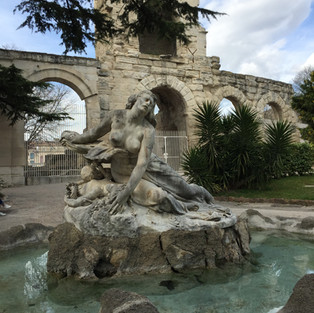Four hours on a high speed train and, viola, we are in the south of France. Provence is beautiful in April. The weather continues to be spectacular. We picked Arles (pronounced "Arl") for our first stop for no particular reason other than it had a nice feel to it when we were looking for interesting places to see and stay during our time in France. As the trip got closer, we learned that Arles is the small town where Vincent Van Gogh lived the last two years of his tragically short life. It was here that he painted his most well-known pieces. In letters to his sister, we learn that he loved it here, was moved by the people and the colors. He arrived in February, when the town was blanketed in snow, and started painting. When spring came he moved his easel outside, and the rest is history. None of his art can be found in Arles today, but almost all of the images he painted are still here.
The yellow house he rented (shown in one of the "Van Gogh Easels" positioned around town to assist the tourists in locating his painting spots) was destroyed by an Allied bomb in 1944 when Arles was liberated from the Nazis. But the house behind it is still here, looking much as it did in 1888. We passed it walking from the train station to our hotel on the Rhône River.
After checking in and dropping our bags, we followed the river for a bit, and then turned toward the old town, passing the same fountains, shuttered homes, and cobbled streets that Van Gogh would have passed.
The Roman Arena is hard to miss. Arles has done a great job preserving the old Roman ruins and monuments. The Arena is still used for sporting events today, especially bull "racing". Bull "fighting" is no longer politically correct, even here, although many local families proudly display their bullfighting legacy and heritage. Van Gogh's paintings focused on the people not the bulls.
The structure of the Arena is impressive. The walkways and exit ports are all still intact, designed to move 20,000 people in and out without the classes ever mixing. The arena floor today is covered in sand, as it was when constructed in 90 AD, to soak up the blood generated in hand-to-hand combat, chariot races and other entertaining events. Roman-era Arles was also culturally sophisticated, as we discovered when we left the Arena, turned a corner, and literally stumbled on the remains of the Theater, which was built a hundred or so years earlier, in 46 BC. Yes, that's Ron, posing as The Thinker, to give the Theater some size perspective. Like the Arena, the Theater remains in use today for concerts and shows.
Leaving the Theater, we traveled forward in time about 1500 years, and plunged into the Middle Ages. To the casual observer, the square called Republic Place looks like any other French town's main square. There is the usual obelisk transported from some conquered Egyptian land, surrounded by a fountain, and framed by old buildings, such as the obligatory Hotel de Ville (City Hall). The old set of doors facing the square could be anything. We never suspected it was a very, very old church, St. Trophime, built between the 12th and 15th centuries, on the site of a 5th Century basilica.
A bulletin board near the entrance advertises the next pilgrimage. For 800 years, pilgrims have stopped (and continue to stop) in this church to pray on their way to Santiago de Compostela in northwest Spain. It is not a fancy church. There is no marble on the floors, or columns, or walls. The floors are the original stone, worn smooth over time. The walls are covered with tapestries. It was damp, and cold, and strangely peaceful inside. Being in a place this old and sacred can be mesmerizing.
I have often read in guidebooks that "such and such relics" are in "such and such church". Church relics I have come to learn are the physical remains (bones) of important people - saints, bishops, kings, popes. But I had never actually seen relics, I have only ever seen the vaults or other markings indicating the location where said relics were safely stored. But St. Trophime's in Arles proudly and openly displays the skulls and bones of many of its honored dead, visible through the glass and iron tomb-like caskets in the alcoves encircling the church. Ashes to ashes, dust to dust....
Back out into the sunlight, we went once more in search of the Van Gogh easels. This one is called "The Entrance to the Public Garden".
Next stop was the courtyard of the hospital where Van Gogh was treated when he cut his ear off. Yikes! It looks remarkably like it did in his time.
Van Gogh's cafe scene was painted at night - I have read that he was the first painter to paint at night. This cafe was not actually yellow at the time it was his subject, it just appeared yellow in the burning gas lights. The current owner of the cafe has painted it yellow, perhaps to capitalize on the Van Gogh tourist trade.
No Van Gogh walk would be complete without Starry Starry Night. There are actually two by that name. The painting most are familiar with was painted later, in St. Remy. This is his Arles Starry Night, and I am looking out the hotel window as I write this, looking at the same bridge. No stars tonight out my window, but plenty in my minds eye.
I can almost hear Don McClains' Vincent echoing across the water:
Starry starry night Paint your palette blue and gray Look out on a summer's day With eyes that know the darkness in my soul Shadows on the hills Sketch the trees and the daffodils Catch the breeze and the winter chills In colors on the snowy linen land






































































Comentários